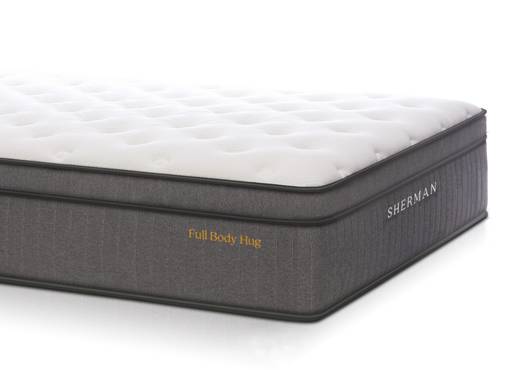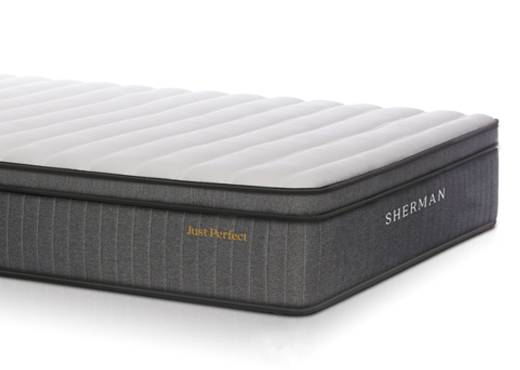There are quite a few different types of spring units used in mattress manufacturing and they all have pro’s and con’s. Generally, the pocket spring unit is considered by most manufacturers and experts as the best type of spring unit for comfort and conformance and is generally used in premium style and more expensive mattresses.
All of the Sherman mattresses use a premium pocket spring, but this article discusses all of the spring units available in mattresses in Australia.

POCKET SPRINGS/ POCKET COILS (also known in USA as Marshall coils).
Said to have been invented by James Marshall in Canada in 1899, this style of spring unit only became common in the 1970’s when manufacturers found a way to produce the style of spring unit en masse. Prior to this, the units were sewn together by hand.
Individual, floating coils of wire are encased in pockets of fabric that allow the springs to move independently of each other and contour extremely well to the sleeper’s body form. Mattress experts agree that pocket spring units provide unsurpassed support and comfort when compared to any other type of mattress spring unit.
Most good quality pocket spring units will have at least 600 individual pockets in a Queen size unit, which is more than enough to provide the appropriate support and conformity for all sleepers. Lately, some manufacturers have found a way to cram in more pockets and use this as a marketing feature. Beware of this, as this doesn’t always bring extra benefits to the sleeper but almost always means that the mattress can be sold at a higher price (see Micro-coil overlays below).
An important note about pocket spring units is that due to the fact that the metal coils are not held together by anything else other than thin fabric, it is not the most durable of spring units. It is essential that the unit is surrounded by steel perimeter springs in order to keep the entire unit together (as shown above). Without these perimeter frames, the outside rows can simply be pulled or ripped away and this is a common problem with the rolled-up, bed-in-a-box style of mattress that incorporate pocket springs in their specifications.
Another issue with pocket springs in the bed-in-a-box mattresses is that they offer little in the way of edge support. You will notice this when you try to sit on the edge of these mattresses and can also give you a feeling of “rolling out” when you sleep up to the side of these mattresses.
PROS: Pocket spring mattresses offer superior conformance, comfort and pressure relief than any other type of mattress spring. A softer style of pocket spring unit can also be comfortable enough to sleep on long after the foam in a mattress has lost it’s comfort so you may be able to sleep on this style of mattress for a lot longer before needing to replace it.
CONS: These are not the most robust spring unit but will always last longer than the foam in a mattress.

MINI POCKET SPRING
The mini pocket spring is a secondary spring unit, usually found on top of a foundational pocket spring unit but is sometimes placed over a Bonnell or LFK spring unit. The main purpose of this secondary unit is to replace foams in the comfort layers of a mattress so the individual coils in a mini pocket need to be much softer than you would find in standard pocket spring units. These are not generally used for support so a foundational spring is always needed underneath them.
Mini pocket springs are now being used in the cushion seats in couches and sofas as they offer the user longer lasting comfort as well as increased air flow when compared to using solid foam cushions.
It is important to note that manufacturers will count these extra coils and use them in their marketing of the mattress, but this does not mean the mattress is better quality or will bring any noticeable difference to the comfort or support for the sleeper.

MICRO-COIL OVERLAYS (also known as Micro Pockets and Nano Coils).
This component has suddenly become popular with manufacturers seeking to find new ways to market their products.
The units consist of many small springs, sometimes only a few mm high, all sewn together in a layer of little pockets, similar to a large batch of ravioli pasta before it has been cut into individual pieces.
Manufacturers can layer these on top of each other and then claim to have thousands of coils in the mattress (knowing that some shoppers will think the more coils, the better). However, since these tiny little springs can be easily pressed flat between your fingers, the benefits of these micro-coils for the sleeper is highly dubious.
A popular TV ad at the moment spruiks a mattress with “4000 coils!!”. I can only guess that the manufacturer has used several layers of these micro-coils for no other reason than to make this bold claim.

BONNELL SPRING
The Bonnell spring unit is what you will normally find in budget mattresses in Australia along with Single or King Single size mattresses.
Manufacturers also use them in “Commercial Grade” mattresses under the premise that the springs are longer lasting than pocket springs. This claim may be true but can be negated by the fact that is the foam comfort layers that will always wear out before the mattress spring unit.
The spring unit is made up of many hourglass-shaped coils, all tied together with rows of metal “helical coils” (these are long corkscrew wires that coil through the top of each spring as they are inserted across the top of the spring unit).
The entire unit is then surrounded by perimeter frames at the top and bottom of the unit.
Most Queen sized Bonnell spring units contain approximately 360 coils, but of course, can be manufactured with less or more, depending on the size of the coils and/or the quality of the spring unit.
The fact that the coils in the Bonnell unit are tied together comes at the expense of body conformity for the sleeper. Wherever you depress the unit, the surrounding coils will also be pushed down, unlike the pocket spring unit where the individual coils react independently of each other.
PRO’S: The Bonnell spring is a fairly robust, long lasting spring unit and can be produced for a low cost.
CON’S: Any tied spring unit like this, the LFK and the continuous coil unit will move or “shimmy” considerably as the sleeper moves. This will not be noticeable when an individual is sleeping alone on a mattress but I don’t recommend this type of spring unit for couples to sleep on where partner disturbance is a concern.

LFK SPRING (also known as Offset coils).
An air of mystery surrounds this spring unit and you won’t find too much information on the internet. It’s no mystery though, it’s just not a commonly used spring unit in Australia – the exception to that is that this is the style of spring used in Australian mattresses sold under the brand “Posturepedic”.
Not many people can even tell you where the name LFK comes from or stands for. I have read that is stands for “Left Facing Knot” but this is not correct. The best answer I’ve heard is that “LFK” is an acronym for the long, convoluted name given to a type of spring-manufacturing machines invented by the Swiss company Spühl Anderson, now owned by Leggett & Platt.
However, this type of spring is not only manufactured by Spühl Anderson and Leggett & Platt but many other spring makers around the world.
The LFK spring is a tied innerspring unit, similar to the Bonnell spring, consisting of many springs that are held together by dual perimeter frames and tied together by rows of metal “helical wires” (see Bonnell spring).
The entire unit is then surrounded by perimeter frames at the top and bottom of the unit.
The main difference with this type of spring is that, rather than the top of the spring being circular, it is usually a hexagonal shape, which allows the springs to be packed in closer together. Manufacturers claim that this also allows the individual springs to conform more easily to the body, but the fact that each spring is tied together makes the claim dubious.
The individual springs in the LFK unit do not have knots at the top of each spring like the Bonnell coils, rather the end of the coil is left open and angled down into the coil. LFK spring units will generally contain many more springs than a traditional Bonnell spring unit.
PRO’S: The LFK spring is a very heavy-duty, long lasting spring unit.
CON’S: Partner disturbance is a concern with this spring unit, as above with the Bonnell spring.

CONTINUOUS COIL
Often marketed as "Miracle Coil" (just about the most mis-leading marketing term that we know of!).
Generally, this is the cheapest type of mattress spring unit to produce due to the fact that the entire unit is formed by one continuous wire, which is wrapped and shaped into coils in one mechanical motion.
The top of each coil is then tied together by rows of metal “helical wires” (see Bonnell spring). The entire unit is surrounded by perimeter frames at the top and bottom of the unit.
In a continuous coil unit, each coil may only turn two or three times, meaning that the unit does not “give” or respond to depression as easily as other types of coils. The entire unit can also consist of much less wire than a Bonnell or LFK unit, which also contributes to it’s lower cost to manufacture.
I am not a fan of the continuous coil, in my mind it exists only as a way for manufacturers to cut cost out of a mattress.
Ironically, this style of spring unit can sometimes be marketed as a premium style of spring but the truth is that there is simply no real benefit for a sleeper on a continuous coil spring (when compared to the other types of mattress springs).
PRO’S: Without any bias, I really cannot think of any pros here.
CONS: The continuous coil is not as robust as the Bonnell or LFK spring units and will usually rock from side to side quite noticeably whenever the sleeper moves on the mattress.
Go back to this article: What's the best mattress?




